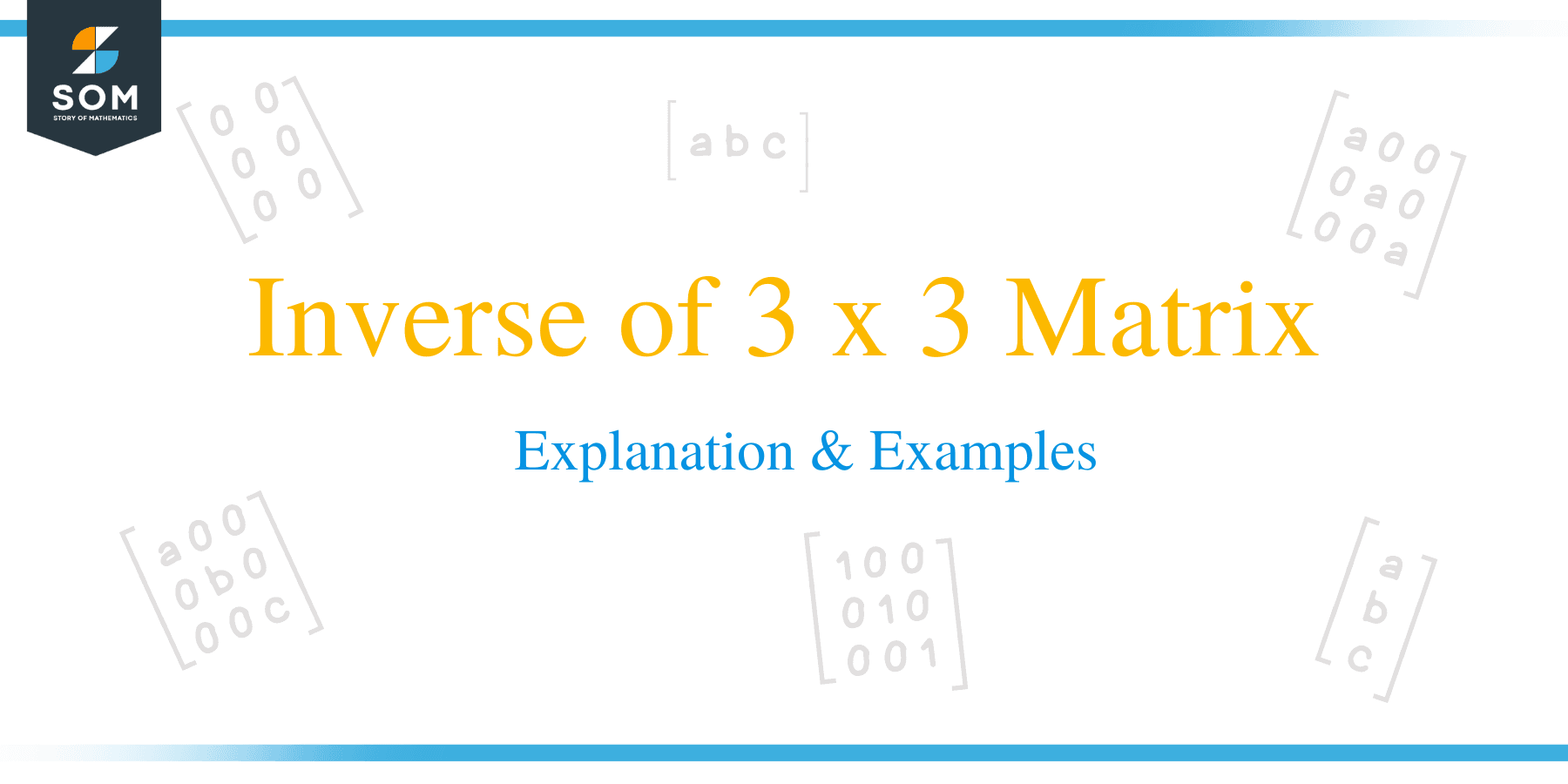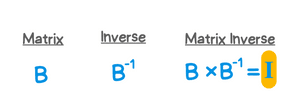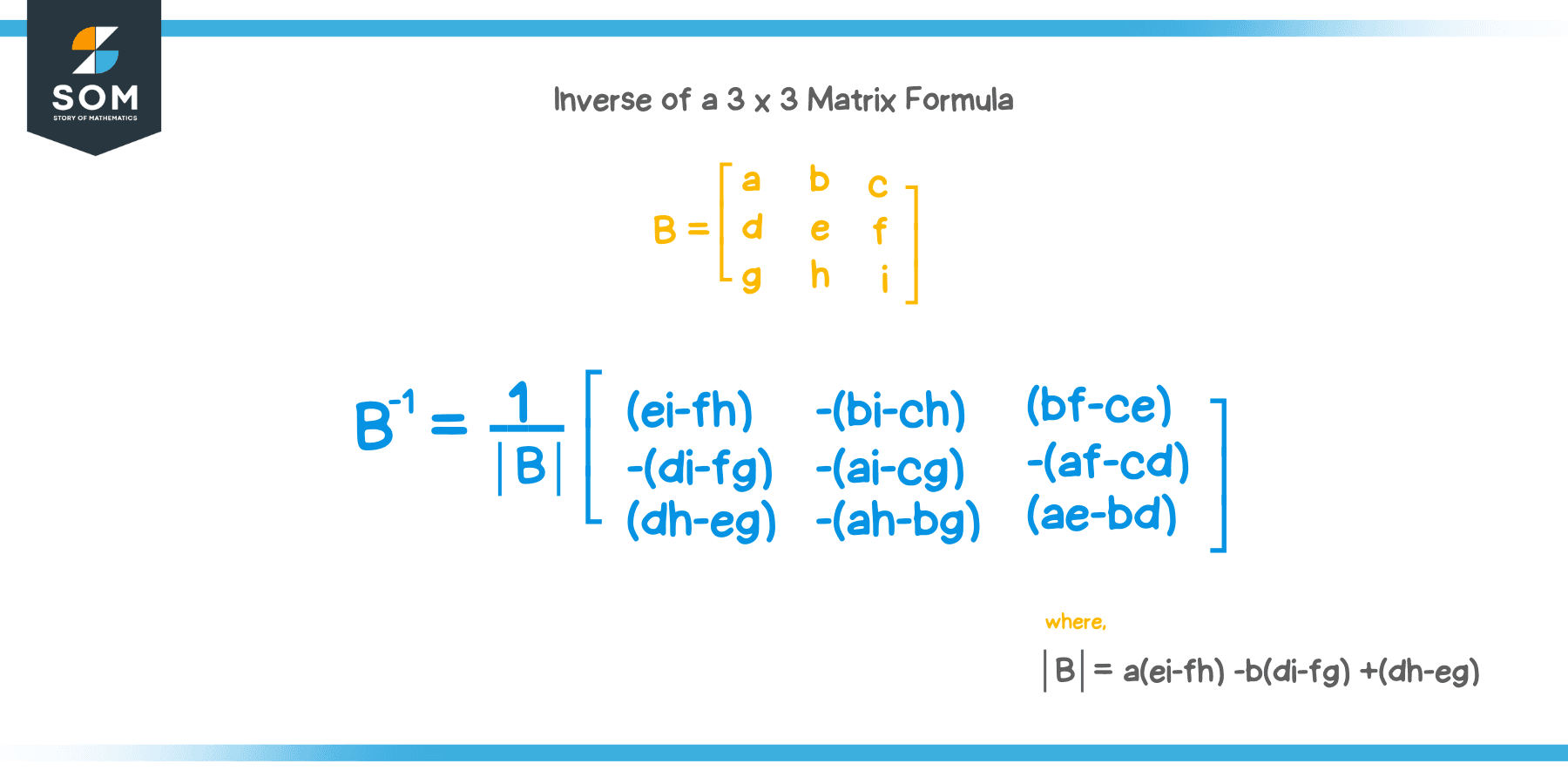- Home
- >
- Inverse of a 3×3 matrix – Explanation & Examples
JUMP TO TOPIC
Inverse of 3 x 3 Matrix – Explanation & Examples
 The inverse of a matrix is significant in linear algebra. It helps us solve a system of linear equations. We can find the inverse of square matrices only. Some matrices do not have inverses. So, what is the inverse of a matrix?
The inverse of a matrix is significant in linear algebra. It helps us solve a system of linear equations. We can find the inverse of square matrices only. Some matrices do not have inverses. So, what is the inverse of a matrix?
The inverse of a matrix $ A $ is $ A^{ – 1 } $, such that multiplying the matrix with its inverse results in the identity matrix, $ I $.
In this lesson, we will take a brief look at what an inverse matrix is, how to find the inverse of a $ 3 \times 3 $ matrix, and the formula for the inverse of a $ 3 \times 3 $ matrix. We will look at a couple of examples and some practice problems for you to try out!
What is the Inverse of a Matrix?
In matrix algebra, matrix inverse plays the same role as a reciprocal in number systems. Inverse matrix is the matrix with which we can multiply another matrix to get the identity matrix (the matrix equivalent of the number $ 1 $)! To know more about the identity matrix, please check here.
Consider the $ 3 \times 3 $ matrix shown below:
$ B = \begin{bmatrix} a & b & c \\ d & e & f \\ g & h & i \end {bmatrix} $
We denote the inverse of this matrix as $ B^{ – 1 } $.

The multiplicative inverse (reciprocal) in the number system and the inverse matrix in matrices play the same role. Also, the identity matrix ($ I $ ) (in matrices domain) plays the same role as the number one ( $ 1 $ ).
How to Find the Inverse of a 3 x 3 Matrix
So how do we find the inverse of a $ 3 \times 3 $ matrix?
To find the inverse of a matrix, we can use a formula that requires a few points to be satisfied before its usage.
For a matrix to have an inverse, it has to satisfy $ 2 $ conditions:
- The matrix needs to be a square matrix (the number of rows must be equal to the number of columns).
- The determinant of the matrix (this is a scalar value of a matrix from a few operations done on its elements) must not be $ 0 $.
Remember, not all matrices that are square matrices have an inverse. A matrix whose determinant is $ 0 $ is not invertible (doesn’t have an inverse) and is known as a singular matrix.
Read more about singular matrices here!
The formula for the inverse of a $ 3 \times 3 $ matrix is quite messy! Nonetheless, let’s tackle it!!
3 x 3 Inverse Matrix Formula
Consider the $ 3 \times 3 $ matrix shown below:
$ A = \begin{bmatrix} a & b & c \\ d & e & f \\ g & h & i \end {bmatrix} $
The formula for the inverse of a $ 3 \times 3 $ matrix (Matrix $ A $) is given as:
$ A^{ – 1 } = \frac{ 1 }{ det ( A ) } \begin{bmatrix} { (ei – fh) } & { – (bi – ch) } & {(bf – ce)} \\ { – (di- fg) } & { (ai – cg)} & { – (af – cd)} \\ { (dh – eg)} & { – (ah – bg)} & {(ae – bd)} \end {bmatrix} $
Where $ det( A ) $ is the determinant of the $ 3\times 3 $ matrix given as:
$ det(A) = a(ei – fh) – b(di – fg) + c(dh – eg) $
Tough!
Tough!
But don’t worry, after working out several questions, it will come to you naturally!
Let’s calculate the inverse of a $ 3 \times 3 $ matrix ( Matrix $ C $ ) shown below:
$ C = \begin{bmatrix} 1 & 2 & 1 \\ 3 & 4 & 1 \\ { – 1 } & 2 & { – 1 } \end {bmatrix} $
Before we calculate the inverse, we have to check the $ 2 $ conditions outlined above.
- Is it a square matrix?
Yes, it is a $ 3 \times 3 $ square matrix!
- Is the determinant equal to $ 0 $?
Let’s calculate the determinant of Matrix $ C $ by using the determinant formula for a $ 3 \times 3 $ matrix.
$ | C | = a(ei – fh) – b(di – fg) + c(dh – eg) $
$ = 1( – 4 – 2 ) – 2(- 3 – ( – 1 ) ) + 1(6 – ( – 4 ) ) $
$ = 1( – 6 ) – 2( – 2 ) + 1 ( 10 ) $
$ = 8 $
The determinant isn’t $ 0 $. So, we can go ahead and calculate the inverse using the formula we just learned. Shown below:
$ C^{ – 1} = \frac{ 1 }{ det( C ) } \begin{bmatrix} { ( ei – fh ) } & { – ( bi – ch ) } & { ( bf – ce ) } \\ { – ( di – fg ) } & { ( ai – cg ) } & { – ( af – cd ) } \\ { ( dh – eg ) } & { – ( ah – bg ) } & { ( ae – bd ) } \end {bmatrix} $
$ C^{ – 1} = \frac{ 1 }{ 8 } \begin{bmatrix} { – 6 } & { 4 } & { – 2 } \\ { 2 } & { 0 } & { 2 } \\ { 10 } & { – 4 } & { – 2 } \end {bmatrix} $
$ C^{ – 1 } = \begin{bmatrix} { – \frac{ 6 }{ 8 } } & { \frac{ 4 }{ 8 } } & { – \frac{ 2 }{ 8 } }\\ { \frac{ 2 }{ 8 } } & { 0 } & { \frac{ 2 }{ 8 } } \\ { \frac{ 10 }{8} } & { – \frac{ 4 }{ 8 } } & { – \frac{ 2 }{ 8 } } \end{bmatrix} $
Note: We multiplied the scalar constant, $ \frac{ 1 }{ 8 } $, with each element of the matrix. This is the scalar multiplication of a matrix.
Let’s reduce the fractions and write the final answer:
$ C^{ – 1 } = \begin{bmatrix} { – \frac{ 3 }{ 4 } } & { \frac{ 1 }{ 2 } } & {- \frac{ 1 }{ 4 } } \\ { \frac{ 1 }{ 4 } } & 0 & { \frac{ 1 }{ 4 } } \\ { \frac{ 5 }{ 4 } } & {- \frac{ 1 }{ 2 } } & {- \frac{ 1 }{ 4 }} \end {bmatrix} $
Let us look at some examples to enhance our understanding further!
Example 1
Given $ A = \begin{bmatrix} 0 & 1 & 4 \\ { – 1 } & { – 1 } & 1 \\ 4 & { – 2 } & 0 \end{bmatrix} $, find $A^{ – 1 }$.
Solution
We will use the formula for the inverse of a $ 3 \times 3 $ matrix to find the inverse of Matrix $ A $. Shown below:
$ A^{- 1} = \frac{ 1 }{a(ei – fh) – b(di – fg) + c(dh – eg)} \begin{bmatrix} { ( ei – fh ) } & { – ( bi – ch ) } & { ( bf – ce ) } \\ { – ( di – fg ) } & { ( ai – cg ) } & { – ( af – cd ) } \\ { ( dh – eg ) } & { – ( ah – bg ) } & { ( ae – bd ) } \end {bmatrix} $
$ A^{ – 1 } = \frac{ 1 }{0( 2 ) – 1( -4 ) + 4( 6 ) } \begin{bmatrix} 2 & -8 & 5 \\ 4 & -16 & -4 \\ 6 & 4 & 1 \end {bmatrix} $
$ A^{ – 1 } = \frac{ 1 }{ 28 } \begin{bmatrix} 2 & -8 & 5 \\ 4 & -16 & -4 \\ 6 & 4 & 1 \end {bmatrix} $
$ A^{ – 1 } = \begin{bmatrix} \frac{ 1 }{ 14 } & – \frac{ 2 }{ 7 } & \frac{ 5 }{ 28 } \\ \frac{ 1 }{ 7 } & -\frac{ 4 }{ 7 } & -\frac{ 1 }{ 7 } \\ \frac{ 3 }{ 14 } & \frac{ 1 }{ 7 } & \frac{ 1 }{ 28 } \end {bmatrix} $
Example 2
Given $ A= \begin{bmatrix} 2 & 2 & 1 \\ 0 & 1 & 0 \\ 1 & 2 & 1 \end {bmatrix} $ and $ B= \begin{bmatrix} 1 & 0 & 1 \\ 0 & 1 & 0 \\ 1 & { – 2 } & 2 \end {bmatrix}$, confirm if Matrix $ B $ is the inverse of Matrix $ A $.
Solution
For Matrix $ B $ to be the inverse of Matrix $, A $, the matrix multiplication between these two matrices should result in an identity matrix ($ 3 \times 3 $ identity matrix). If so, $ B $ is the inverse of $ A $.
Let’s check:
$ A\times B= \begin{bmatrix} 2 & 2 & 1 \\ 0 & 1 & 0 \\ 1 & 2 & 1 \end {bmatrix} \times \begin{bmatrix} 1 & 0 & 1 \\ 0 & 1 & 0 \\ 1 & -2 & 2 \end {bmatrix} $
$ =\begin{bmatrix} { (2)(1) + (2)(0) + (1)(1) } & { (2)(0) + (2)(1) + (1)(-2) } & { (2)(1) + (2)(0) + (1)(2) } \\ { (0)(1) + (1)(0) + (0)(1) } & { (0)(0) + (1)(1) + (0)(-2) } & { (0)(1) + (1)(0) + (0)(2) } \\ { (1)(1) + (2)(0) + (1)(1)} & { (1)(0) + (2)(1) + (1)(-2) } & {(1)(1) + (2)(0) + (1)(2) } \end {bmatrix} $
$ = \begin{bmatrix} 3 & 0 & 4 \\ 0 & 1 & 0 \\ 2 & 0 & 3 \end{bmatrix} $
This is not the $ 3 \times 3 $ identity matrix!
Thus, Matrix $ B $ is not the inverse of Matrix $ A $.
If you want to review matrix multiplication, please check this lesson out!
Practice Questions
Given $ K = \begin{bmatrix} 0 & 2 & -1 \\ 3 & -2 & 1 \\ 3 & 2 & -1 \end {bmatrix} $, find $ K^{ – 1 } $.
- Calculate $ A^{ – 1 }$ for Matrix $A$ shown below:
$ A = \begin{bmatrix} 1 & – 9 & 1 \\ – 3 & – 1 & 9 \end{bmatrix} $ - Calculate the inverse of the $ 3 \times 3 $ matrix shown below:
$ D = \begin{bmatrix} 2 & 4 & 8 \\ 0 & 1 & 0 \\ 1 & -4 & 1 \end{bmatrix} $
Answers
- This matrix does not have an inverse because this matrix’s determinant is equal to $ 0 $!
Recall that the determinant cannot be $ 0 $ for a matrix to have an inverse. Let’s check the value of the determinant:
$ | K | = 0( 2 – 2 ) – 2( – 3 – 3 ) +( – 1 )( 6 + 6 ) $
$ | K | = 0( 0 ) – 2 ( – 6 ) – 1( 12 ) $
$ | K | = 12 – 12 $
$ | K | = 0 $Since the determinant is $ 0 $, this matrix will not have an inverse!
- If you look at this matrix carefully, you will see that it is not a square matrix!. It is a $ 2 \times 3 $ matrix ( $ 2 $ rows and $ 3 $ columns). Recall that we cannot find the inverse of a non-square matrix.
Thus, Matrix $ A $ doesn’t have an inverse! - We will use the formula for the inverse of a $ 3 \times 3 $ matrix to find the inverse of Matrix $ D $. Shown below:
$ D^{ – 1 } = \frac{ 1 }{a(ei – fh) – b(di – fg) + c(dh – eg)} \begin{bmatrix} { ( ei – fh ) } & { – ( bi – ch ) } & { ( bf – ce ) } \\ { – ( di – fg ) } & { ( ai – cg ) } & { – ( af – cd ) } \\ { ( dh – eg ) } & { – ( ah – bg ) } & { ( ae – bd ) } \end {bmatrix} $
$ D^{ – 1 } = \frac{ 1 }{2( 1 ) – 4( 0 ) +8( – 1 ) } \begin{bmatrix} 1 & – 36 & – 8 \\ 0 & – 6 & 0 \\ – 1 & 12 & 2 \end {bmatrix} $
$ D^{ – 1 } = \frac{ 1 }{ – 6 } \begin{bmatrix} 1 & – 36 & – 8 \\ 0 & – 6 & 0 \\ – 1 & 12 & 2 \end {bmatrix} $
$ D^{ – 1 } = \begin{bmatrix} – \frac{ 1 }{ 6 } & 6 & \frac{ 4 }{ 3 } \\ 0 & 1 & 0 \\ \frac{ 1 }{ 6 } & – 2 & – \frac{ 1 }{ 3 } \end {bmatrix} $
